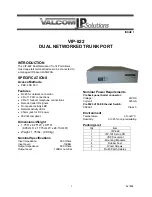
250
Step Command
Remarks
1.
Enter system view.
system-view
N/A
2.
Create an address pool and
enter its view.
ipv6 dhcp pool
pool-name
By default, no DHCPv6 address
pool exists.
3.
Advertise the subnet assigned
to DHCPv6 clients.
network
prefix/prefix-length
[
preferred-lifetime
preferred-lifetime
valid-lifetime
valid-lifetime
]
export-route
By default, the subnet assigned
to DHCPv6 clients are not
advertised.
Applying a DHCPv6 address pool to a VPN
instance
If a DHCPv6 address pool is applied to a VPN instance, the DHCPv6 server assigns IPv6 addresses
in this address pool to clients in the VPN instance. Addresses in this address pool will not be
assigned to clients on the public network.
The DHCPv6 server can obtain the VPN instance to which a DHCPv6 client belongs from the
following information:
•
The client's VPN information stored in authentication modules, such as IPoE.
•
The VPN information of the DHCPv6 server's interface that receives DHCPv6 packets from the
client.
The VPN information from authentication modules takes priority over the VPN information of the
receiving interface.
To apply a DHCPv6 address pool to a VPN instance:
Step Command
Remarks
1.
Enter system view.
system-view
N/A
2.
Create an address pool and
enter its view.
ipv6 dhcp pool
pool-name
By default, no DHCPv6 address
pool exists.
3.
Apply the address pool to a
VPN instance.
vpn-instance
vpn-instance-name
By default, the address pool is
not applied to any VPN
instance.
Configuring DHCPv6 logging on the DHCPv6
server
The DHCPv6 logging feature enables the DHCPv6 server to generate DHCPv6 logs and send them
to the information center. For information about the log destination and output rule configuration in
the information center, see
Network Management and Monitoring Configuration Guide
.
Disable this feature when the log generation affects the device performance or reduces the address
and prefix allocation efficiency. For example, this situation might occur when a large number of
clients frequently come online or go offline.
To configure DHCPv6 logging on the DHCPv6 server:
Step Command
Remarks
1.
Enter system view.
system-view
N/A
















































